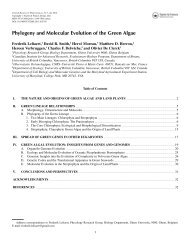Phylogeny and molecular evolution of green algae - Phycology ...
Phylogeny and molecular evolution of green algae - Phycology ...
Phylogeny and molecular evolution of green algae - Phycology ...
You also want an ePaper? Increase the reach of your titles
YUMPU automatically turns print PDFs into web optimized ePapers that Google loves.
6 CHAPTER 1<br />
Chlorophyta<br />
The current classification <strong>of</strong> the Chlorophyta, which relies on a combination <strong>of</strong> morphology,<br />
ultrastructural features <strong>of</strong> the flagellar root system, <strong>and</strong> characters relating to the mitotic spindle<br />
during cell division <strong>and</strong> cytokinesis, has been largely confirmed by phylogenetic analysis (Figs. 4 <strong>and</strong><br />
5, Table 1) (Mattox <strong>and</strong> Stewart 1984, Pröschold <strong>and</strong> Leliaert 2007). Four major groups, commonly<br />
regarded as classes, are recognized by consensus: “Prasinophyceae”, Chlorophyceae,<br />
Trebouxiophyceae <strong>and</strong> Ulvophyceae (Fig. 3) (reviewed in Lewis <strong>and</strong> McCourt 2004). The<br />
prasinophytes form a paraphyletic group <strong>of</strong> unicellular flagellates or coccoid cells at the base <strong>of</strong> the<br />
Chlorophyta (Steinkötter et al. 1994, Fawley et al. 2000, Lopez-Bautista <strong>and</strong> Chapman 2003, Guillou<br />
et al. 2004). The Ulvophyceae, Trebouxiophyceae <strong>and</strong> Chlorophyceae are resolved as a wellsupported<br />
clade (UTC clade) in most studies (Mishler et al. 1994), but the relationships among these<br />
lineages form the basis <strong>of</strong> a longst<strong>and</strong>ing debate. Furthermore, the monophyly <strong>of</strong> the three classes<br />
remains to be demonstrated unequivocally (O'Kelly <strong>and</strong> Floyd 1984a, Zechman et al. 1990, Krienitz et<br />
al. 2003).<br />
Certain ultrastructural characteristic are shared between the Ulvophyceae, Trebouxiophyceae <strong>and</strong><br />
Chlorophyceae. In all representatives the nuclear envelope remains intact until the chromosomes<br />
finally separate (closed mitosis). The flagella are anchored in the cell by means <strong>of</strong> cruciate flagellar<br />
roots with mostly an X-2-X-2 configuration <strong>of</strong> the microtubules (Moestrup 1978, Lewis <strong>and</strong> McCourt<br />
2004). Other ultrastructural observations are useful diagnostic characters to separate the three<br />
classes. The orientation <strong>of</strong> the basal bodies, short cylindrical arrays <strong>of</strong> microtubules at the base <strong>of</strong> a<br />
flagellum, is one <strong>of</strong> those discriminative characters. The Ulvophyceae <strong>and</strong> Trebouxiophyceae have a<br />
counter-clockwise orientation <strong>of</strong> the basal bodies, while the Chlorophyceae have a direct opposite or<br />
clockwise orientation <strong>of</strong> the basal bodies (Fig. 4) (Lewis <strong>and</strong> McCourt 2004). The Ulvophyceae have a<br />
persistent mitotic spindle which helps to keep the daughter nuclei separate until cytokinesis has<br />
been accomplished. The Trebouxiophyceae <strong>and</strong> Chlorophyceae both have a non-persistent mitotic<br />
spindle <strong>and</strong> a phycoplast composed <strong>of</strong> a set <strong>of</strong> microtubules which lie parallel to the plane <strong>of</strong><br />
cytokinesis (Fig. 5) (Friedl 1995, Lewis <strong>and</strong> McCourt 2004). Based on these ultrastructural<br />
observations Mattox <strong>and</strong> Stewart (1984) suggest that the Ulvophyceae diverged first, followed by the<br />
Trebouxiophyceae <strong>and</strong> Chlorophyceae (Fig. 6). While Mattox <strong>and</strong> Stewart (1984) based their<br />
classification on the orientation <strong>of</strong> the basal bodies in the flagellar apparatus <strong>and</strong> differences <strong>of</strong> the<br />
mitotic spindle during cell division <strong>and</strong> cytokinesis, Sluiman (1989) only used the orientation <strong>of</strong> basal<br />
bodies in the flagellar apparatus as diagnostic character <strong>and</strong> merged the Trebouxiophyceae with the<br />
Ulvophyceae based on the counter-clockwise orientation <strong>of</strong> the basal bodies in the flagellar<br />
apparatus (Fig. 6).<br />
Molecular phylogenetic studies have been highly inconclusive about the relationships between UTC<br />
classes (Fig. 6). The first <strong>molecular</strong> phylogenies based on small subunit nuclear ribosomal DNA (SSU<br />
or 18S nrDNA) sequences all observed that Ulvophyceae branch first, leaving Trebouxiophyceae <strong>and</strong><br />
Chlorophyceae as sisters (Friedl 1995, Bhattacharya et al. 1996, Krienitz et al. 2001, Lopez-Bautista<br />
<strong>and</strong> Chapman 2003), while more recent SSU nrDNA phylogenitic studies using exp<strong>and</strong>ed taxon<br />
sampling <strong>and</strong> likelihood-based methods with more realistic models <strong>of</strong> sequence <strong>evolution</strong> revealed a<br />
sister relation between Chlorophyceae <strong>and</strong> Ulvophyceae (Friedl <strong>and</strong> O'Kelly 2002, Lewis <strong>and</strong> Lewis<br />
2005, Watanabe <strong>and</strong> Nakayama 2007). Chloroplast gene order data <strong>and</strong> genomic structural features

















